Top speed 800 km/h Length 12 m Engine type Turbofan | Wingspan 9.63 m Unit cost 10,000,000–10,000,000 USD First flight 1990 | |
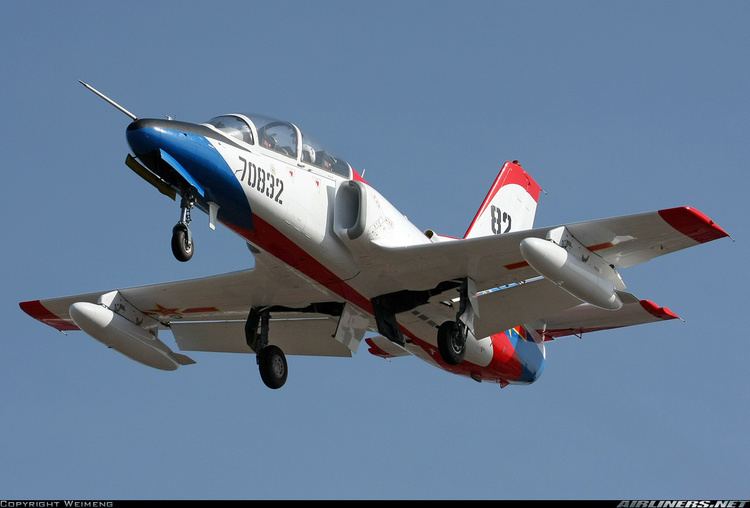 | ||
Manufacturers Hongdu Aviation Industry Group, Pakistan Aeronautical Complex | ||
The Hongdu JL-8 (Nanchang JL-8), also known as the Karakorum-8 or K-8 for short, is a two-seat intermediate jet trainer and light attack aircraft designed in the People's Republic of China by China Nanchang Aircraft Manufacturing Corporation. The primary contractor is the Hongdu Aviation Industry Corporation. Its export variant, K-8 Karakorum is co-produced by the Pakistan Aeronautical Complex for the Pakistan Air Force.
Contents
- Development
- Design
- Airframe and flight control system
- Cockpit and avionics
- Propulsion and fuel system
- Operational history
- Myanmar
- Variants
- Operators
- Former Operators
- Incidents
- Specifications K 8
- References
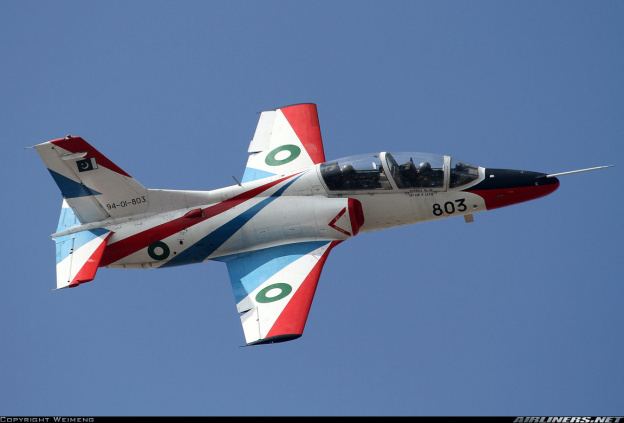
Development

The JL-8 trainer was proposed as a joint cooperation effort between the governments of Pakistan and the People's Republic of China in 1986. The name was changed on the suggestion of Pakistan's then President General Zia ul Haq to Karakorum-8 to represent the friendship between the two countries. Work on the design started in 1987 at Nanchang Aircraft Manufacturing Company (NAMC) at Nanchang, Jiangshi Province in South Central China. The Chinese chief designer of the aircraft was Shi Ping (石屏), heading a team of over 100 Chinese Engineers, while Air Cdr Muhammad Younas Tbt (M), SI(M) was the chief designer from the Pakistani side leading a team of over 20 Pakistani engineers.
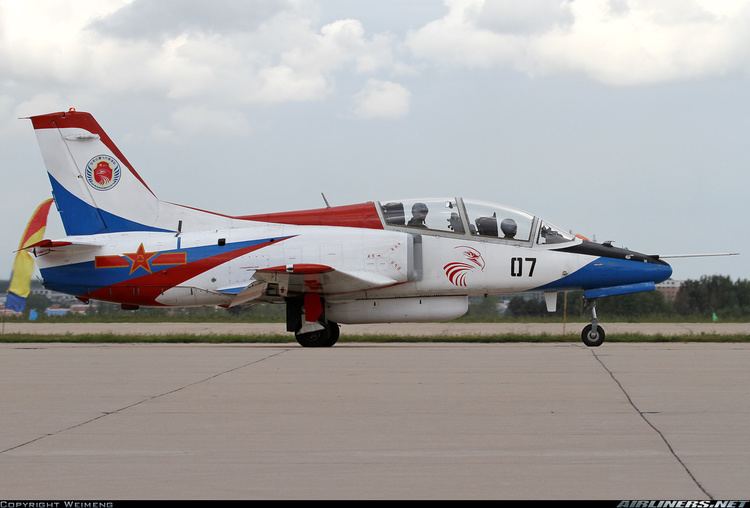
Initially, the aircraft was to feature many United States parts, including Garrett TFE-731 engine and several cockpit displays along with communication and avionics systems, but due to political developments and an embargo from the US at the end of the 1980s following the Tiananmen Square protests of 1989, other vendors had to be used. The first prototype was built in 1989, with the first flight taking place on 21 November 1990 by Chief Test Pilot Col Yang Yao (杨耀). Flight testing continued from 1991 to 1993 by a Flight Test Team consisting of four Chinese and two Pakistani Pilots (Group Captain Waqar Ahmad and Squadron Leader Nadeem Sherwani).

After four prototypes were built, production of a small batch of 24 aircraft was launched in 1992. Chinese share out of these was 18, while Pakistan Air Force (PAF) received six K-8s in 1994. In 1995, PAF decided to order 75 more K-8s to gradually replace its fleet of Cessna T-37 Tweet basic trainers. In 2010, the number of K-8 aircraft in PAF were estimated to be around 40. The People's Liberation Army Air Force (PLAAF) received its first six JL-8 trainers in 1995 following additional upgrades. The Chinese model uses WS-11, a Chinese-manufactured version of the Ukrainian Ivchenko AI-25 (DV-2) engine. The PLAAF is anticipated to continue adding the JL-8 trainer to its fleet to replace its obsolete trainers, such as the Chengdu JJ-5. In 2008, the number of JL-8s in PLAAF inventory were estimated to be over 120 aircraft.
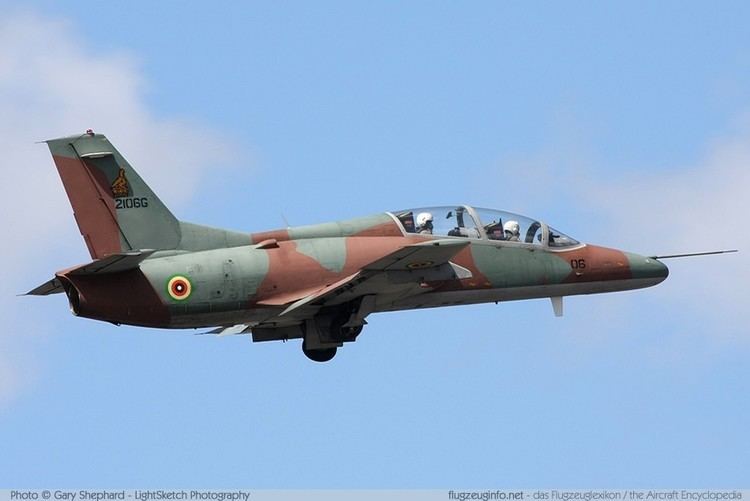
Other nations have shown interest in the trainer and it now also serves in the air forces of Egypt, Sri Lanka and Zimbabwe. While the type primarily serves as a basic and advanced trainer, it can also be used in the close air support or even air combat role when appropriately armed.
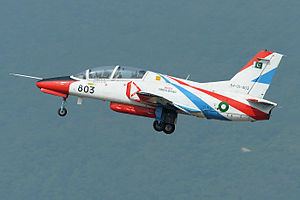
The export-variant K-8 Karakorum Basic Common Advanced Jet Trainer is co-produced by China National Aero-Technology Import & Export Corporation (CATIC) for export markets other than Pakistan, while later aircraft for Pakistan have been built by the Aircraft Manufacturing Factory (AMF), Pakistan Aeronautical Complex. The latest export variant is the K-8P version, which currently is operated by the PAF. The K-8P has an advanced avionics package of integrated head-up display (HUD), multi-function displays (MFDs) and comes equipped with MFD-integrated GPS and ILS/TACAN systems. It also features Armament racks for carrying a variety of training and operational bombs up to 250 kg, pod mounted 23 mm canon as well as PL-5 / 7 /AIM-9 P launchers. Studies for putting a Griffo Radar in the nose are well under way. In Sep 2011, NAMC rolled out another 12 K-8P for undisclosed foreign client.
In 2008 Venezuela announced the purchase of 18 K-8 aircraft. Currently the K-8 is being marketed by China to the air forces of the Philippines; and to Indonesia, as a replacement for Indonesia's BAE Hawk jet trainers. In 2009, the Bolivian government approved a deal to purchase 6 K-8P aircraft for use in anti-drug operations. The total number of K-8 aircraft produced till 2010 in all variants were estimated to be over 500, with production rate of approximately 24 aircraft per year continuing.
Design
The JL-8 / K-8 has a multi-role capability for training and, with little modification, can also be used for airfield defense. The aircraft is supposed to be as cost-effective as possible, with a short turn-around time and low maintenance requirements. The JL-8 for the domestic Chinese market and its export variants, K-8E and K-8P, have different powerplants and avionics.
Airframe and flight control system
A low-wing monoplane design primarily constructed of aluminum alloys, the JL-8 / K-8 airframe structure is designed for an 8,000 flight hour service life.
The landing gear is of tricycle configuration, with hydraulically operated wheel brakes and nose-wheel steering.
The flight control system operates a set of conventional flight control surfaces with a rigid push-rod transmission system, which itself is electrically or hydraulically operated. The aileron control system, of irreversible servo-control type, is composed of a hydraulic booster, an artificial-feel device, a feel trim actuator and a rigid push-rod transmission mechanism. The elevator and rudder control systems are of reversible push-rod type.
Cockpit and avionics
The JL-8 / K-8 cockpit arrangement is designed to be as close to that of a combat aircraft as possible. A transparent plastic canopy covering both cockpits, which are arranged in a tandem seating position, is supposed to give a good all-round field of view.
A Rockwell Collins Electronic Flight Instrument System (EFIS) is fitted, with multi-function displays (MFDs) in the front and rear cockpits showing information to the pilots. The emergency cockpit escape system is made up of two Martin-Baker MK-10L rocket-assisted ejection seats which are zero-zero capable, meaning they can be used safely at zero altitude and zero speed. Although JL-8 is designed to have limited capability to deliver air-to-ground weapons, the first rocket attack practice was only completed in May 2011.
Ultra high frequency (UHF) and very high frequency (VHF) radio communication systems are present, along with a Tactical Air Navigation (TACAN) and automatic direction finder (ADF). An instrument landing system (ILS) is also available. These systems can be tailored to meet the requirements of the customer.
A strap-on Environmental control system (ECS) from AlliedSignal provides air conditioning to the cockpit. It is capable of operating when the aircraft is on the ground, under ambient temperatures of -40 to +52 °C, as well as in the air.
Propulsion and fuel system
The JL-8, for the Chinese domestic market, was originally powered by the Ukrainian Ivchenko-Progress AI-25TLK turbofan jet engine with 16.9 KN of thrust, but this has been replaced by the WS-11, the Chinese-manufactured copy of the AI-25TLK. Export variants (K-8P, K-8E) use the lower powered Honeywell TFE731-2A-2A modular turbofan, which has digital electronic engine control (DEEC) with 15.6 KN thrust, provided the US government approves sale of the engine to the customer.
A hydro-mechanical fuel control system delivers fuel to the engine. The aircraft's fuel system consists of the fuel tanks and the fuel supply/transfer, vent/pressurization, fuel quantity measuring/indicating, fuel refueling and fuel drain subsystems. The total fuel is contained in two fuselage bladder-type rubber tanks and a wing integral tank of 1720 lb. The capacity of each drop tank is 250 litres.
Operational history
The K-8 took part in its first aerial display in 1993 at the Singapore Air Show and since then has participated at Air Shows at a number of places including Dubai, Paris, Farnborough, Bangkok, Zuhai etc. It was shown to the Pakistani public for the first time on 23 March 1994 at the Pakistan Day Parade. It became part of the Sherdils (Lion Hearts) aerobatics team of the Pakistan Air Force in 2009 and carried out its first public display on 6 April 2010. K-8 replaced the team's previous T-37 Tweet aircraft.
Myanmar
In late December 2012 and early January 2013, during the Kachin conflict, Burma Air Force K-8s have been used to strike Kachin rebel's positions in the north of the country.
Variants
Data from: SinoDefence.com
Operators
Former Operators
Incidents
At 9am on 5 September 2008, a K-8 Karakorum trainer of the Air Force of Zimbabwe crashed over the town of Gweru, killing both pilots. The aircraft was on a routine training sortie.
On 21 July 2010, a K-8 Karakorum trainer of the Venezuela Air Force crashed just 4 months after its delivery. The pilots ejected and managed to survive.
On 20 August 2011, two Zimbabwe Air Force K-8's collided in mid-air while taking part in a fly past at the funeral of retired General Solomon Mujuru. Pieces were seen to fall from the aircraft, but they both appeared to land safely.
On 23 October 2012, a K-8 Karakorum training plane lost directional control during take off from Julius Nyerere International Airport, Dar es Salaam. Both pilots ejected but one of them was killed on impact. The plane left the runway and struck a container.
On 27 November 2012, a K-8 Karakorum belonging to Venezuela's Bolivarian Air Force, suffered a malfunction and crashed near the El Libertador Air Base, in the Palo Negro parish of the city of Maracay, Aragua state. Both pilots ejected and suffered only minor injuries. The plane was scheduled to participate on the air show to celebrate Venezuelan Air Force Day, later that day.
On 26 July 2013 at 12:50 A.M., a K-8 Karakorum belonging to Venezuela's Bolivarian Air Force, crashed in the Gen. Rafael Urdaneta Air Base, near Maracaibo, Zulia State, while participating in night exercises. The pilot, First Lieutenant Milenia Bolivar, ejected and was transported to a local hospital, where she is said to be in good condition.
Specifications (K-8)
Data from Pakistan Aeronautical Complex, SinoDefence.com, Jane's Aircraft Recognition Guide
General characteristics
Performance
Armament
Avionics
